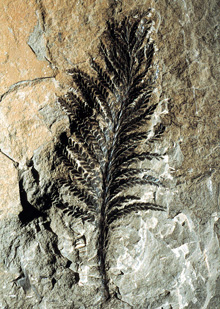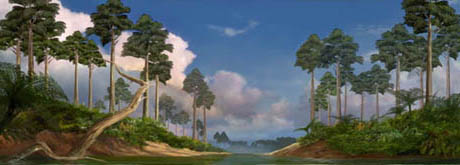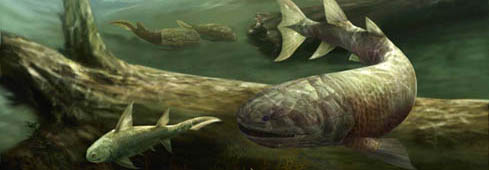 |
 |
 |
 |
 |
Produced
by the Population Genetics and Evolution class, Furman University |
||||
 |
 |
 |
 |
 |
Produced
by the Population Genetics and Evolution class, Furman University |
||||
 |
The
Devonian |
 |
||
 |
The Devonian Period was marked by some of the most important evolutionary events in the history of life. The Devonain is sometimes called "The Age of Fishes" because of the extraordinary radiations that occur in this group. As the ostracoderms wane, the jawed fishes come to dominate. The placoderms filled many niches, with the 10m Dunkleosteus filling the role of apex predator. The cartilaginous fishes, like the shark Cladoselache, evolved as well. The bony fishes (Class Osteichthyes) also evolved and radiated, including the lobe-finned fishes like Eustheopteron that would, through intermediates like Panderichthyes and Tiktaalik, evolve into the labrinthodonts like Ichthyostega - the first four-legged land vertebrates. Other changes were occuring on land, as well; the primitive short vascular plants like the rhyniophytes and zosterophyllophytes evolved into progressively taller plants, culminating in the first forests on earth that were dominated by the progymnosperm Archaeopteris. Plants provided a food source for terrestrial invertebrates, and the first insects like Rhyniognatha may have fed on plant spores. Early protospiders like Attercopus evolved, as well. Arthropds were not giving up the oceans without a fight, however; the largest arthropod that ever lived, the giant sea scorpion Jaekelopterus, remained a fearsome top predator. Both on land and sea, vertebrates began to dominate earth's ecosystems in the Devonian. |
 |
||
| Above: Archaeopteris fossil; Photo From: Geological Survey of Canada Below, Devonian Forests from: The Field Museum | Above: Acanthostega; from: wordpress.com Below: Panderichthyes, from: The Field Museum. |
|||
 |
 |
|||